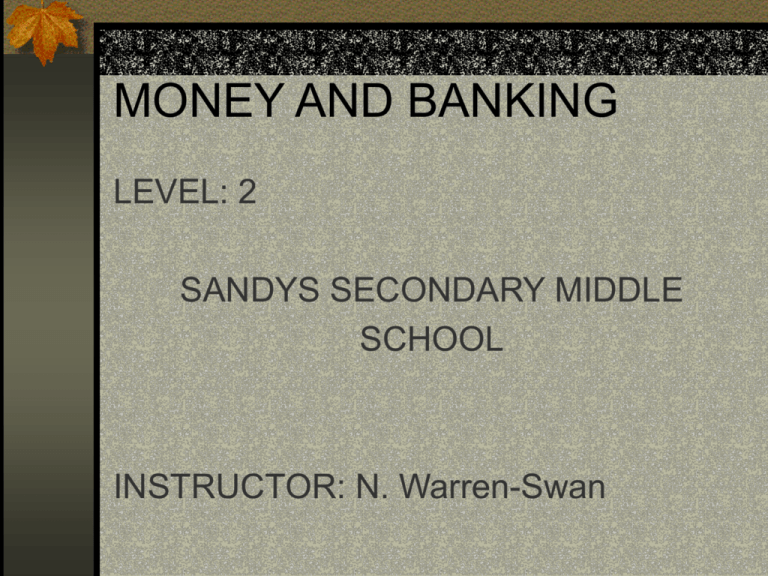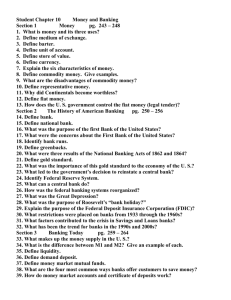money and banking
advertisement

MONEY AND BANKING LEVEL: 2 SANDYS SECONDARY MIDDLE SCHOOL INSTRUCTOR: N. Warren-Swan MONEY AND BANKING VOCABULARY Money Barter Currency Demand deposit Time deposit Withdrawal Interest Checkbook dollars Mortgage Deposit Line of credit Objectives Describe the characteristics of money. What is barter? Define money. Think about what banking institutions do that affects the everyday life of people. BARTER Barter is an ancient method of swapping goods and services and is making a big comeback. An increasing number of countries who strapped for hard currencies are resorting to barter-type trade agreements . Barter between or among nations is called countertrade Banking Careers Tellers Loan Officers Investment Banker Securities Analyst Stockbroker Finance Officers Vault Custodians Money and Banking For more than 2000 years , money has been a desirable good. Such items as seashells, salt, tobacco, and pieces of metal have sometimes served as money. Today we know quite a bit about how to control the value of money without changing its quantity. *money is anything that is generally accepted in exchange for goods and services. Functions of Money •Money acts as a medium of exchange-the means by which goods and services are sold. An employee works in order to be paid in money, which is used to buy the things he or she wants •A store of value-money may be used in many ways. It can be spent, held in a checking or savings account, or some other form. When it is used as a store of value, money is saved and not spent. •A standard of value-the unit by which all values are measured. Characteristics of Money •Divisibility – ability to be divided into small units(coins). •Durability – money should be lasting and not wear out quickly. •Portability – easy and convenient to transfer and carry about. •Stability – money is considered stable when its purchasing power is fairly constant Objective: Describe the operational functions of two types of banking accounts. A customer deposits money into an account and receives a book of checks. Each check the customer writes and signs is an order to the bank to pay on demand.(checking/current) Banks pay you interest for the money thqt you have in your account, as they use it to generate money.(savings/deposit) Objective: Demonstrate the process of maintaining a checking acccount. Student Activity: The student will : Write cheques, Fill in cheque registers Fill out a deposit slips. Read bank statements. Complete for Homework. Banking Institution Effects on Our Daily Lives Services offered: •DIRECT DEPOSIT CURRENCY EXCHANGE •SAVINGS ACCOUNTS •CHECKING ACCOUNTS •SAFE DEPOSIT BOXES •LOANS •MORTGAGES •LETTERS OF CREDIT ATM SERVICES Objective: Identify, investigate careers in banking. Systems analyst Investment portfolio manager Tellers Vault keepers Financial officer Investigate two careers of your choice Objective: Use computer applications in preparing documents used in the banking industry. Student Activity Choose any two or come up with two forms of your own. Prepare an electronic cheque Create an email Create a deposit slip. Create a credit card application. Create a balance sheet Activity 1Quick check 1. What are the three functions of money? 2. Name at least four characteristics of money. 3. Define money , barter and currency. 4. What is the most common form of money used in Bermuda? 5. How is a bank like any other business? 6. Name three basic functions of a bank. 7. List four types of banks. 8. Define vocabulary terms and use in a sentence. 9. Write the currency for the 52 African countries. Home Activity Case Study:Greg Malouf recently received a $10,000 cash gift from his Uncle Alex to use for the education of his children, Jared and Rochelle. Uncle Alex had kept the cash in a safe at home. Like other savers, Uncle Alex did not need to use the $10,000 cash and had set it aside. You have learned that banks accept cash from savers who do not need to use their cash, reserve a portion of the cash deposited, and loan out the remainder as they see fit. For privilege of using savers money banks pay them interest. Banks then charge borrowers interest for the privilege of having to put to immediate use. Thus banks and other financial institutions are financial go between between savers and investors. Home Activity cont’d They gather loanable funds from savers and make them available to investors to use as capital, a factor of production. From an economists’ point of view, was Uncle Alex’s idea keeping the $10,000 cash in a safe good for the economy. Summary Money functions as a medium of exchange, standard of value, and a store of value. The characteristics of money include acceptability, divisibility, and scarcity. All banks accept money in the form of deposits to accounts, transfer money between accounts, and create money by giving out loans to individuals and businesses. There are three types of banking institutions: Commercial Savings and Loans Savings banks






